OXIDIZED BITUMEN 115/15
Content Overview
DESCRIPTION OF OXIDIZED BITUMEN 115/15
Oxidized Bitumen 115/15, also known as blown asphalt 115/15 or blown bitumen 115/15, is produced by blowing air through pure bitumen at high temperatures. This process induces physical changes in the bitumen, predominantly through the polymerization of asphaltene when exposed to airflow, altering its properties to make it more durable and less prone to deformation under stress.
Compared to regular bitumen, oxidized bitumen possesses similar tensile strength but is characterized by a lower penetration grade and a higher softening point, making it more resistant to heat and deformation.
The 115/15 specification denotes the softening point and penetration grade of the bitumen. The first number represents the softening point in degrees Celsius (i.e., 115°C), which indicates the temperature at which the bitumen begins to soften and lose its solid state. The second number signifies the penetration grade (i.e., 15), which measures the depth (in tenths of a millimeter) to which a standard needle can penetrate the bitumen under specified conditions. This number is inversely proportional to the hardness of the bitumen: a lower penetration grade signifies harder bitumen.
WHAT IS OXIDIZED BITUMEN 115/15?
Oxidized bitumen 115/15 is another grade of blown or blown asphalt with specific properties and characteristics. It is commonly used in various industries for different applications.
The “115/15” designation indicates the softening point and penetration values of the bitumen. Here’s what each number represents:
The first number, 115, represents the softening point of the bitumen. In the case of oxidized bitumen 115/15, it signifies that the softening point is approximately 115 degrees Celsius. The softening point indicates the temperature at which the bitumen becomes soft and pliable.
The second number, 15, refers to the penetration value of the bitumen. Penetration is a measure of the consistency and hardness of the bitumen. In the case of oxidized bitumen 115/15, the penetration value typically ranges between 10 and 20 (0.1 mm).
Oxidized bitumen 115/15 is produced through a controlled air blowing process, where air is blown through heated bitumen to modify its physical properties. This process increases the softening point, reduces penetration, and enhances the bitumen’s resistance to weathering, aging, and deformation.
The specific properties of oxidized bitumen 115/15 make it suitable for various applications, including road construction, roofing, and waterproofing. It provides excellent durability, resistance to rutting and cracking, weather resistance, and waterproofing properties.
It’s important to note that while the softening point and penetration range of oxidized bitumen 115/15 are generally consistent, slight variations may exist depending on the specific manufacturing process or regional standards.
OXIDIZED BITUMEN 115/15 OTHER NAMES
Oxidized Bitumen 115/15 is known by several other names in various regions and industries. Some of these alternative names include:
- Blown Asphalt 115/15
- Blown Bitumen 115/15
- Hard Bitumen 115/15
- Oxidizing Bitumen 115/15
- Air Blown Asphalt 115/15
- Air-Rectified Bitumen 115/15
Please note that these names all refer to the same product and its production process, which includes the oxidation of liquid bitumen to achieve specific characteristics such as lower penetration and higher softening points, making it suitable for numerous industrial applications.
OXIDIZED BITUMEN 115/15 HS CODE, CHEMICAL FORMULA AND CAS NUMBER
The HS code (Harmonized System code) for Oxidized Bitumen 115/15, a standard code used in international trade, is 27132000. This globally recognized nomenclature enables the efficient classification and movement of goods across borders.
Oxidized Bitumen 115/15 doesn’t have a specific chemical formula as it’s a complex mixture of hydrocarbons. However, its primary components are hydrocarbons (C5-C25+), with various amounts of oxygen, nitrogen, sulfur, and other trace elements. This composition contributes to its high stability and viscosity, making it an optimal choice for roofing, insulation, and industrial applications.
The CAS (Chemical Abstracts Service) number, a unique identifier assigned to every chemical substance by the American Chemical Society, is complex to assign for bitumen due to its diverse molecular composition. However, the CAS number for bitumen, in general, is 8052-42-4.
OXIDIZED BITUMEN 115/15 PRODUCTION PROCESS
Oxidized Bitumen 115/15 is created by air-blowing process, where air is blown at high temperature through bitumen. Here is a detailed step-by-step guide on how Oxidized Bitumen 115/15 is produced:
Preparation: High quality bitumen is selected as a raw material. This is typically done through vacuum distillation of crude oil, which separates the heavier bitumen from the lighter hydrocarbon materials.
Heating: The selected bitumen is then heated to a high temperature, generally between 240°C – 260°C, in a specially designed oxidation furnace.
Air Blowing: Hot air is blown through the bitumen under controlled conditions. This process triggers a reaction between the bitumen and the oxygen in the air, resulting in the bitumen being “oxidized”. The heat and the amount of air used in this process are closely monitored to produce bitumen of the desired quality.
Cooling and Settling: The oxidized bitumen is then allowed to settle in a specially designed settler. The settler allows the bitumen to cool and any air bubbles to escape.
Testing: Once the oxidized bitumen has settled and cooled, it undergoes testing. Key characteristics such as the softening point and penetration are checked to ensure they meet the specifications for Oxidized Bitumen 115/15.
Packaging: After successful testing, the oxidized bitumen 115/15 is packaged and prepared for shipping. It is commonly packed in craft paper bags, drums, or polyamide bags.
Remember, the production of Oxidized Bitumen 115/15 should always adhere to safety guidelines. As the process involves dealing with high temperatures and potentially flammable materials, it’s important to take necessary precautions to ensure the safety of all involved.
We produce oxidized bitumen 115/15 ( blown asphalt 115/15 ) of the best quality in a variety of types and export them from Iran and the United Arab Emirates to other nations worldwide.
- Iran Oxidized Bitumen 115/15 ( Iran Blown Asphalt 115/15 )
- Emirates Oxidized Bitumen 115/15 ( Emirates Blown Asphalt 115/15 )
OXIDIZED BITUMEN 115/15 ADVANTAGES AND BENEFITS
Oxidized Bitumen 115/15 has a range of advantages and benefits, making it a widely used product in various industries, notably construction and industrial applications. Here are some key advantages and benefits of Oxidized Bitumen 115/15:
Higher Softening Point: Compared to regular bitumen, Oxidized Bitumen 115/15 has a higher softening point, making it more resistant to high ambient temperatures. This prevents it from becoming too soft or fluid in hot weather conditions, ensuring structural stability.
Lower Penetration Grade: Oxidized Bitumen 115/15 has a lower penetration grade than other forms of bitumen, meaning it’s harder and less susceptible to deformation. This makes it suitable for applications where stronger, more rigid materials are needed.
Water Resistant: Oxidized Bitumen 115/15 is water-resistant, making it an excellent sealant for roofing, waterproofing, and as an anti-damp layer in construction projects. This can help to protect structures from water damage and extend their lifespan.
Durability: It is highly durable and resistant to certain chemicals, ensuring long-term performance even under challenging conditions.
Versatility: Due to its unique physical properties, Oxidized Bitumen 115/15 can be used in a wide range of applications, from road construction and roofing to industrial uses such as insulation, sound dampening, and pipe coating.
Ease of Use: While it is solid at ambient temperature, Oxidized Bitumen 115/15 can be easily melted for application by heating, allowing for efficient and flexible use on job sites.
It’s important to ensure the quality of the Oxidized Bitumen 115/15 used in any project, as its performance and the benefits it provides will depend on its production and composition.
OXIDIZED BITUMEN 115/15 PROPERTIES
Oxidized Bitumen 115/15 is a type of bitumen whose physical properties have been improved through the process of oxidation. The process of oxidation not only makes it more viscous but also improves its temperature susceptibility, making it more suitable for certain industrial applications.
The key properties of Oxidized Bitumen 115/15 include:
Penetration: The penetration level of Oxidized Bitumen 115/15 is quite low, usually within the range of 15 deci-millimeter at 25°C. This means it’s a harder form of bitumen and is less susceptible to becoming overly soft under high temperatures.
Softening Point: The softening point of Oxidized Bitumen 115/15 is high, typically around 115°C. This means it can withstand higher temperatures before it starts to lose its solid form and become viscous, which makes it suitable for use in warmer climates or applications where high-temperature resistance is required.
Ductility: Oxidized Bitumen 115/15 is less ductile compared to other types of bitumen. This property enhances its strength and durability, making it ideal for applications requiring a firm and sturdy material.
Solubility: Oxidized Bitumen 115/15 is soluble in organic solvents like toluene, making it useful in certain industrial applications.
Temperature Susceptibility: Oxidized Bitumen 115/15 exhibits a higher resistance to temperature variations, maintaining its form and function in a wide range of temperatures. This makes it an excellent choice for applications exposed to variable weather conditions.
Water Resistance: This form of bitumen is also resistant to water, which is why it’s commonly used as a waterproofing agent in construction projects.
These properties make Oxidized Bitumen 115/15 an excellent choice for a variety of applications, including roofing, insulating, and paving.
OXIDIZED BITUMEN 115/15 COMPONENTS AND MATERIALS
Oxidized Bitumen 115/15, also known as blown asphalt, is produced from crude oil through a refining process. It doesn’t consist of a single chemical compound but a complex blend of organic liquids that are composed primarily of highly condensed polycyclic aromatic hydrocarbons. Here is a general breakdown of the components and materials in Oxidized Bitumen 115/15:
Asphaltenes: These are the solid or semi-solid fraction of bitumen and provide the bulk of the structural matrix in the material. Asphaltenes have a complex molecular structure containing a high number of aromatic rings.
Resins: These are the components of bitumen that surround the asphaltene molecules and bind them together, giving bitumen its adhesion and waterproofing characteristics.
Saturates: These are the non-aromatic part of the bitumen, composed primarily of saturated hydrocarbons.
Aromatics: These are complex hydrocarbons, including condensed ring and partial-ring aromatics. They work as a solvent, keeping the asphaltenes dispersed and providing bitumen its plasticity.
Trace Elements: Bitumen also contains small amounts of sulfur, nitrogen, oxygen, and metals like nickel and vanadium.
During the oxidation process, the bitumen is heated and air is blown through it, causing the constituents of the bitumen to react with oxygen. This results in an increase in the asphaltene content and a decrease in the volatile components, thereby making the bitumen harder and less penetrable.
It’s important to note that the exact composition can vary, depending on the source of the crude oil and the specific manufacturing process used. As a result, the final properties of the Oxidized Bitumen 115/15 can vary, making it suitable for different applications.
OXIDIZED BITUMEN 115/15 MAINTENANCE
Oxidized Bitumen 115/15, also known as blown asphalt, is a robust and durable material used in a range of applications, including roofing, insulation, and industrial uses. However, to ensure its longevity and optimal performance, proper maintenance practices are essential. Here are some maintenance guidelines:
Storage: Oxidized Bitumen 115/15 should be stored in a cool, dry place, away from direct sunlight and sources of ignition or heat, to prevent degradation and ensure its physical properties remain stable.
Handling: When handling, appropriate protective clothing should be worn due to the bitumen’s high temperature, especially during the melting process.
Temperature Management: Oxidized Bitumen 115/15 melts at high temperatures, so it’s crucial to control the temperature during the melting process to avoid overheating, which can degrade the material and alter its properties.
Periodic Inspection: Regular inspection of applications of Oxidized Bitumen 115/15 (like roofing or insulation) is necessary to check for any damage or wear and tear, enabling timely repair or replacement.
Professional Assistance: For large-scale applications or issues that can’t be resolved through simple maintenance, seek assistance from professionals knowledgeable in handling oxidized bitumen.
Disposal: Any waste material or remnants should be disposed of as per local environmental and waste management regulations.
Maintaining Oxidized Bitumen 115/15 properly will not only extend its lifespan but also enhance its performance and reliability.
OXIDIZED BITUMEN 115/15 INSTALLATION
The installation process of Oxidized Bitumen 115/15, also known as blown asphalt, depends on the application, but generally involves heating the bitumen to its melting point before application. Here’s a general guideline on how Oxidized Bitumen 115/15 is typically installed:
Melting: Oxidized Bitumen 115/15 is a solid material at room temperature and needs to be heated to a high temperature (over its softening point) to make it fluid for application. It’s crucial to heat it gradually and avoid overheating, which can lead to degradation of the material.
Application: Once the oxidized bitumen has reached the desired fluidity, it can be applied to the surface. The method of application will depend on the specific use. For example, in roofing, it may be mopped, poured, or applied with a squeegee. In industrial applications, it might be applied using a spray system.
Cooling: After application, the bitumen is allowed to cool. As it cools, it will return to its solid state, adhering firmly to the surface to which it’s been applied.
Inspection: After the bitumen has cooled and set, an inspection is usually carried out to ensure that the material has been applied evenly and that there are no defects.
Safety is of utmost importance during the installation process. The bitumen needs to be heated to high temperatures for application, which can present burn hazards. Additionally, oxidized bitumen can release fumes when heated, so adequate ventilation is essential. Always use appropriate personal protective equipment (PPE) and follow safety guidelines when handling and installing Oxidized Bitumen 115/15.
OXIDIZED BITUMEN 115/15 DURABILITY
Oxidized Bitumen 115/15, also known as blown asphalt, is recognized for its superior durability due to its unique manufacturing process and properties. The oxidation process enhances the bitumen’s performance in several ways that contribute to its long-lasting durability:
Higher Softening Point: Oxidized Bitumen 115/15 has a high softening point, which means it can withstand higher temperatures compared to other types of bitumen before becoming too soft or liquid. This characteristic makes it less likely to deform under high temperatures, enhancing its durability.
Lower Penetration: This type of bitumen has a lower penetration grade, meaning it’s harder and less likely to deform under pressure. This hardness increases its resistance to wear and tear, contributing to its long lifespan.
Resistance to Water and Certain Chemicals: Oxidized Bitumen 115/15 is water-resistant, which helps to protect structures from water damage, and it is also resistant to certain chemicals, making it more durable in various environments.
Less Temperature Susceptibility: It is less susceptible to changes in temperature, meaning it maintains its form and function in both hotter and colder conditions better than other types of bitumen. This reduces the likelihood of cracking and other forms of damage due to temperature fluctuations.
These properties make Oxidized Bitumen 115/15 an excellent material for applications where durability and longevity are important, such as in road construction, roofing, insulation, and other industrial uses. However, the actual lifespan can depend on many factors, including the quality of the installation, the conditions it is exposed to, and how well it is maintained.
OXIDIZED BITUMEN 115/15 PERFORMANCE
Oxidized Bitumen 115/15, also known as blown asphalt, is recognized for its strong performance in a variety of applications. This type of bitumen undergoes a process of oxidation that improves its temperature susceptibility and hardens it, making it more suitable for specific uses compared to regular bitumen. Here’s an overview of its performance attributes:
Temperature Resilience: Oxidized Bitumen 115/15 has a high softening point (around 115°C), meaning it can resist becoming too soft or fluid in high ambient temperatures. This feature ensures its performance stability under hot conditions, a vital attribute for applications in warm climates or situations where heat resistance is required.
Low Penetration Grade: With a low penetration grade, Oxidized Bitumen 115/15 is harder and less prone to deform under pressure. This hardness means it can withstand significant wear and tear, making it ideal for heavy-duty applications, such as road construction or roofing in heavy traffic areas.
Water Resistance: Oxidized Bitumen 115/15 is also water-resistant, making it an excellent sealant for roofing, waterproofing, and as an anti-damp layer in construction projects. This helps protect structures from water damage and preserves the integrity of the material in wet conditions.
Chemical Resistance: This type of bitumen is also resistant to certain chemicals, increasing its suitability for industrial applications and enhancing its longevity in various environments.
Versatility: The unique physical properties of Oxidized Bitumen 115/15 allow it to be used across a wide range of applications, from road construction and roofing to industrial uses like insulation, sound dampening, and pipe coating.
In summary, the performance of Oxidized Bitumen 115/15 makes it an excellent material for a variety of demanding applications. However, it’s important to note that the overall performance can be influenced by factors such as the quality of the material, the specifics of the application, and the conditions it is exposed to.
OXIDIZED BITUMEN 115/15 SPECIFICATIONS
Bitumen 115/15 | Test method | Unit | Specification |
Specific gravity @25/25 C | ASTM D70 | (Kg/m3) | 1.05 approx. |
Penetration @ 25°c | ASTM D5 | mm/10 | 10/20 |
Softening point °c | ASTM D36 | °C | 110/120 |
Ductility @25 °c | ASTM D113 | Cm | 1.5min |
Loss on heating(wt) % | ASTM D6 | Wt. % | 0.2 max |
Flashpoint c | ASTM D92 | °C | 250 min |
Solubility is CS2(wt) % | ASTM D4 | Wt. % | 99.5 max |
Spot test | A.A.S.H.O.T102 | — | Negative |
OXIDIZED BITUMEN 115/15 APPLICATIONS AND USES
Oxidized Bitumen 115/15 has several applications, including road construction, hydropower projects, roofing, flooring, mastics, oil and gas industries, and electrical applications.
Roads: Bitumen 115/15 can be used for road building, road paving, and road maintenance. It can be used as an addition in asphalts for roads, highways, trains, and parking lots. Among other applications of this grade of bitumen, it can be used for railroad ballast.
- Hydro projects: Blown Bitumen 115-15 is used as a canal lining material. This sort of bitumen can be used in further hydro projects such as embankment and dam building, hydraulic structures, and dam lining.
- Roofing: Blown Asphalt 115-15 is used in roofing felts, shingle roofs, damp-proof coating compositions, carriage roofing compounds, liquid roof coatings, and plastic cements. Typically, it is the greatest option for roof waterproofing.
- Flooring: flooring is one of Oxidised Bitumen 115/15‘s primary applications. In order to prevent corrosion on the surface of chemical plants, fertilizer plants, steel plants, and other plants, acid- and alkali-resistant bitumen mastic can be used. It is also capable of repairing parquet flooring. This grade of bitumen is also used for tennis courts.
- Oil and gas industry: in addition to Cutback Bitumen MC30, blown bitumen 115/15 is widely used to protect pipelines from corrosion and rust.
- In the electrical sector: bitumen 115-15 is used as an adhesive for laminated boards. It has the capacity to seal electrical junction boxes. It has use in the cable sector, lithium-ion batteries, and wires.
- Painting: Bitumen 115/15 combination with solvent high performance bitumen paint is an affordable anti-corrosive and protective solution for a broad variety of typical construction materials, including iron, steel, wood, and concrete, fiber reinforced cement panels, and masonry. It creates a flexible, quick-drying coating that is waterproof, weatherproof, and corrosion resistant. It is also sometimes used for the backing of carpets and moquettes.
OXIDIZED BITUMEN 115/15 SAFETY TIPS
Working with Oxidized Bitumen 115/15, also known as blown asphalt, involves high temperatures and potentially hazardous materials. Hence, safety must be a top priority. Here are some safety tips for handling and using Oxidized Bitumen 115/15:
Protective Equipment: Always wear appropriate personal protective equipment (PPE). This includes heat-resistant gloves, safety shoes, long-sleeved shirts, long trousers, and safety goggles. If hot bitumen splashes are a risk, a face shield should be used.
Ventilation: Bitumen can release fumes when heated, which can be harmful if inhaled. Make sure the work area is well-ventilated, especially in enclosed spaces.
Temperature Control: Bitumen needs to be heated before use, but overheating can cause it to degrade and can increase the risk of burns and fires. Always monitor and control the temperature carefully.
Fire Safety: Bitumen is flammable at high temperatures. Keep bitumen away from open flames or sparks and have appropriate fire extinguishing equipment on hand.
Safe Handling: Hot bitumen can cause severe burns. Avoid direct contact with hot bitumen, and don’t allow it to splash. Use tools and techniques that minimize the risk of splashing.
Training: Ensure that everyone working with bitumen is properly trained on safe handling procedures and knows what to do in an emergency.
First Aid: In the case of skin contact, cool the area quickly with cold water (do not use ice). For eye contact, rinse immediately with plenty of water and seek medical attention. In case of inhalation, move to fresh air and rest.
Always refer to the Material Safety Data Sheet (MSDS) provided by the manufacturer for specific safety guidelines related to Oxidized Bitumen 115/15.
OXIDIZED BITUMEN 115/15 PRICE AND BUY
When evaluating the Oxidized Bitumen 115/15 market, understanding the price dynamics is crucial. The price of Oxidized Bitumen 115/15 is subject to various influencing factors, ranging from the international crude oil prices to the demands of specific industries.
The Oxidized Bitumen 115/15 price is directly related to the global oil market, as the petroleum byproduct is its primary ingredient. In other words, if crude oil prices rise, so does the price of Oxidized Bitumen 115/15. Therefore, monitoring global oil trends can give a reliable hint on the direction of bitumen prices.
In addition, the specific industry demands also affect the price of Oxidized Bitumen 115/15. For instance, industries such as roofing, road construction, and waterproofing heavily use this type of bitumen. As a result, an increase in construction activities leads to a surge in demand and subsequently to a rise in Oxidized Bitumen 115/15 prices.
The oxidized bitumen 115/15 price list also varies from supplier to supplier. It’s important to note that while the price list of Oxidized Bitumen 115/15 may vary, the quality of the product should always be the primary concern. Trusted manufacturers, like Petro Naft, ensure that while providing competitive prices, the quality is never compromised.
Furthermore, transportation costs and export/import regulations in various countries can impact the price of Oxidized Bitumen 115/15. More stringent regulations or higher transportation costs can drive up the final price of the product.
In conclusion, the Oxidized Bitumen 115/15 price is influenced by various factors from crude oil prices and industrial demand to supplier variations and transport costs. As we at Petro Naft understand these market dynamics, we provide the most competitive prices while upholding the highest product quality standards.
Oxidized Bitumen 115/15 Manufacturers and Suppliers
In the world of construction and industrial materials, oxidized bitumen 115/15 plays a crucial role. Consequently, understanding the landscape of Oxidized Bitumen 115/15 suppliers and manufacturers is important for potential buyers.
From a global perspective, oxidized bitumen 115/15 manufacturers and suppliers are distributed in various regions. These producers have a significant role in meeting the rising demands for this indispensable material in various industries.
Nearby Oxidized Bitumen 115/15 manufacturers such as Petro Naft, Shell, and Exxon Mobil play pivotal roles in their respective regional markets. Petro Naft, for instance, has a robust production line ensuring high-quality oxidized bitumen 115/15, catering to both local and international demands. Other global players like Shell and Exxon Mobil also contribute significantly to the global supply.
Factories producing Oxidized Bitumen 115/15 are often equipped with cutting-edge technology to ensure the efficiency and quality of the production process. They also adhere to environmental regulations and safety standards, providing a sustainable and reliable supply to the global market.
When it comes to Oxidized Bitumen 115/15 suppliers, companies often distinguish themselves by offering additional services such as logistics and custom-tailored products. These firms understand that each project may require a unique approach, and they are ready to meet these specific needs.
In conclusion, the global landscape of Oxidized Bitumen 115/15 manufacturers and suppliers is diverse and competitive. Whether you’re looking for a nearby Oxidized Bitumen 115/15 manufacturer or an international supplier, it’s essential to choose a partner that values quality, sustainability, and customer-oriented services, like Petro Naft.
Where To Buy Oxidized Bitumen 115/15
Procuring quality Oxidized Bitumen 115/15 can often be a challenging process due to the variety of options available in the market. Here is a comprehensive guide on where to buy Oxidized Bitumen 115/15 and what to consider during the process.
The first step in buying Oxidized Bitumen 115/15 involves identifying reputable suppliers or manufacturers. These entities should demonstrate a history of producing high-quality bitumen, such as Petro Naft, Exxon Mobil, or Shell. It is essential to conduct thorough research on their production methods, quality control processes, and customer reviews.
While deciding where to buy Oxidized Bitumen 115/15, consider the supplier’s location in relation to your operation. If you operate globally, choosing a manufacturer with an extensive international supply chain, like Petro Naft, could be beneficial.
Additionally, look for suppliers that offer comprehensive customer service, including pre-sales consultation and post-sales support. This ensures that any questions or issues can be swiftly addressed, making the overall buying process smoother and more efficient.
To purchase Oxidized Bitumen 115/15, you can directly contact the supplier or manufacturer, request a quote, and arrange for delivery. Most suppliers have dedicated sales teams that can assist you in this process, offering tailored solutions based on your requirements.
In conclusion, buying Oxidized Bitumen 115/15 involves a comprehensive understanding of your needs, thorough research on potential suppliers, and ensuring the selected partner can meet your demands in terms of quality, quantity, and service. With the right approach, procuring Oxidized Bitumen 115/15 can be a straightforward process.
Iran Oxidized Bitumen 115/15 Price
Understanding the Iranian Oxidized Bitumen 115/15 market and its price dynamics is crucial for both local and international players. Given Iran’s significant role in the global bitumen market, its market trends and future forecasts can influence global bitumen price trajectories.
The Oxidized Bitumen 115/15 market price in Iran is primarily influenced by the price of crude oil, similar to global trends. Iran, being a major oil producer, has the advantage of having a substantial supply of the raw material necessary for bitumen production. This can result in more competitive prices compared to countries where crude oil has to be imported.
Iran’s Oxidized Bitumen 115/15 price also hinges on internal factors such as inflation, domestic demand, production costs, and the exchange rate of the Iranian Rial. These factors can cause fluctuations in the Iranian Oxidized Bitumen 115/15 price, and potential buyers need to monitor them closely.
Additionally, the impact of international sanctions and restrictions can influence the Iranian Oxidized Bitumen 115/15 price. When sanctions are imposed, it could restrict the country’s access to certain markets, subsequently affecting demand and prices.
Looking ahead, if the Iranian economy stabilizes and international relations improve, we could foresee a more stable and potentially lower Iran Oxidized Bitumen 115/15 price. However, this forecast is contingent on various political and economic factors, both domestically and globally.
In conclusion, the Iran Oxidized Bitumen 115/15 price is influenced by a complex interplay of domestic and international factors. Understanding these dynamics is crucial for those looking to participate in this market. As a leading bitumen supplier in Iran, Petro Naft continuously monitors these factors to provide its clients with competitive prices and valuable market insights.
Oxidized Bitumen 115/15 Manufacturers and Suppliers in Iran
As one of the world’s top oil and bitumen producers, Iran has a host of Oxidized Bitumen 115/15 manufacturers and suppliers that contribute significantly to the global supply. Whether you’re a buyer seeking a reliable source or an industry enthusiast, a detailed understanding of this landscape is essential.
Iran’s Oxidized Bitumen 115/15 manufacturers operate sophisticated refineries and plants designed to produce high-quality bitumen products. These facilities follow international standards in terms of safety and environmental impacts, ensuring sustainable production practices. Prominent manufacturers include Petro Naft, Jey Oil, and Pasargad Oil.
Petro Naft, one of the leading Iran Oxidized Bitumen 115/15 manufacturers, stands out due to its robust production line, quality assurance processes, and commitment to customer satisfaction. Jey Oil and Pasargad Oil also have a strong presence in the market with their extensive bitumen product ranges.
When it comes to Oxidized Bitumen 115/15 suppliers in Iran, several companies provide not only the product but also comprehensive services. These include logistical support, custom packaging, and dedicated customer service. These sellers in Iran ensure that the product reaches buyers in optimal conditions and on time.
Exploring the landscape of Oxidized Bitumen 115/15 sellers in Iran reveals a wide range of options for potential buyers. These range from large-scale refineries to smaller, more specialized plants. Each has its strengths, and the best fit depends on the buyer’s specific requirements and objectives.
In conclusion, Iran’s Oxidized Bitumen 115/15 manufacturers and suppliers offer robust and diverse options for buyers worldwide. As a potential buyer, exploring these options and understanding their unique selling propositions is crucial to making an informed procurement decision. Companies like Petro Naft stand out due to their comprehensive offerings and commitment to customer satisfaction.
Stay updated with the latest prices of our wide range of Petronaft bitumen types. Explore the information on this page for weekly price updates and make informed decisions for your projects:
PetroNaft Co. manufactures the highest quality Oxidized Bitumen 115/15 ( Blown Asphalt 115/15 ) in different types and exports it from Iran and the UAE to other countries around the world.
- Oxidized Bitumen 115/15 Iran ( Blown Asphalt 115/15 Iran )
- Oxidized Bitumen 115/15 UAE ( Blown Asphalt 115/15 UAE )
OXIDIZED BITUMEN 115/15 PACKING
25Kg Kraft Bag, 25Kg Polyamide Bag, Carton, Drum, and Bulk.
OXIDIZED BITUMEN 115/15 TRANSPORTATION
Oxidized Bitumen 115/15, also known as blown asphalt, is a sensitive material that requires careful handling and specific conditions during transportation and storage. The method and guidelines may vary depending on the packaging format. Here are general transportation and storage tips based on different types of packaging:
25Kg Kraft Bag: These bags should be handled carefully to prevent tearing. They should be stored in a cool, dry place, and stacked properly to prevent the risk of collapse. During transport, ensure they are not exposed to heat sources or moisture.
25Kg Polyamide Bag: These bags have a stronger material than kraft bags, but still should be handled with care to prevent damage. They should be stored away from direct sunlight, heat sources, and moisture. The bags should not be stacked too high to prevent risk of collapse or damage.
Carton: Boxes should be handled gently to avoid crushing or damaging the contents. They should be stored in a cool, dry place, away from heat sources, and should not be stacked too high. During transport, secure the boxes to prevent them from moving and getting damaged.
Drum: Drums should be handled with appropriate equipment like a forklift to prevent injury. They should be stored upright in a cool, dry place, away from heat sources. During transport, drums should be secured to prevent them from rolling or moving.
Bulk: Bulk shipments of Oxidized Bitumen 115/15 are usually transported in specially designed, heated tanker trucks. These trucks should maintain a consistent temperature to keep the bitumen in a liquid state for unloading. The temperature should not be so high as to risk degrading the bitumen or creating safety hazards.
Remember, Oxidized Bitumen 115/15 becomes a liquid at high temperatures and can cause burns if mishandled. Always use the necessary personal protective equipment (PPE) when handling this material, regardless of its packaging. Additionally, local regulations and guidelines regarding the transportation and storage of bituminous products should always be followed.

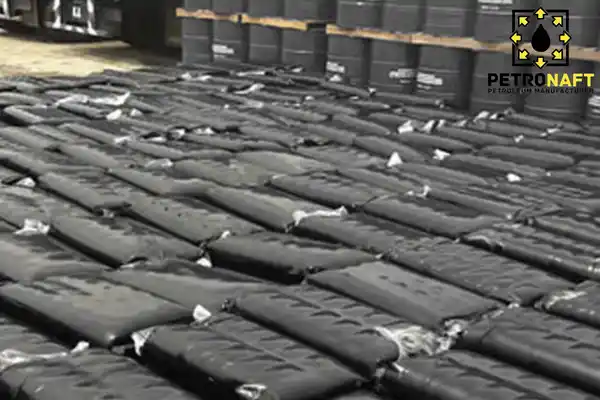
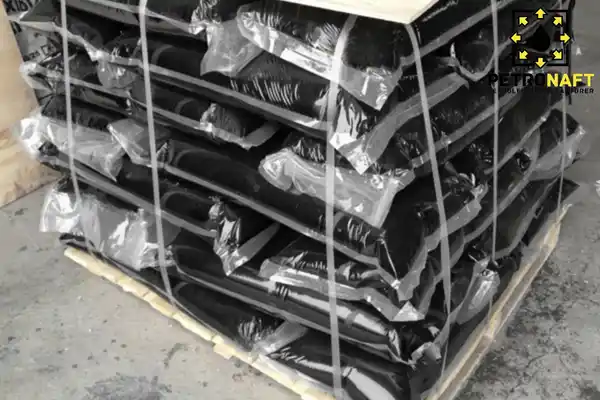
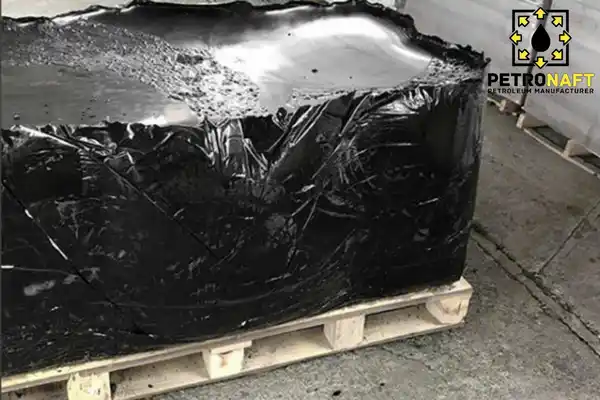
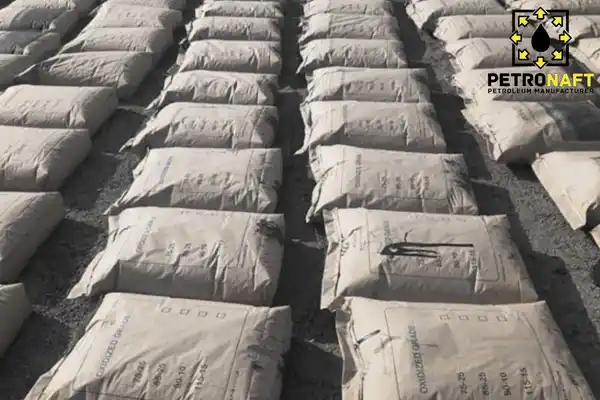
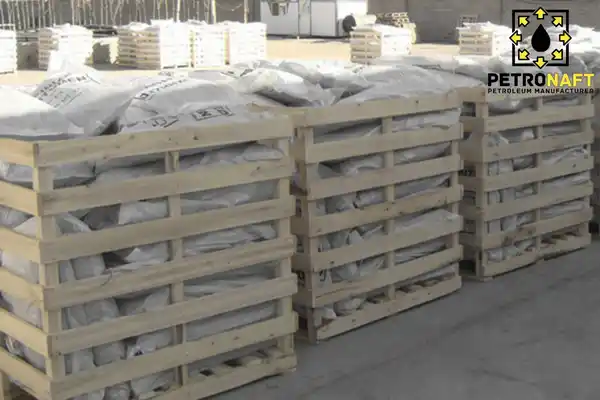
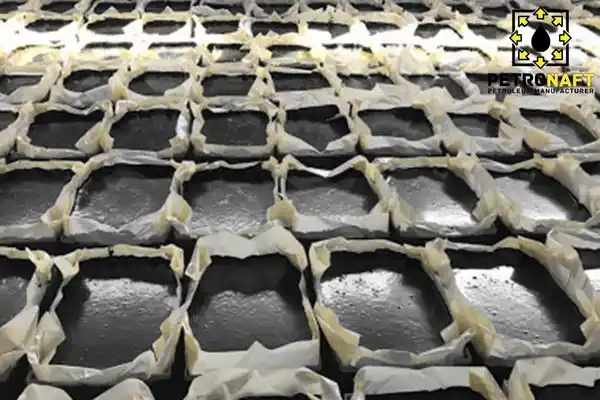
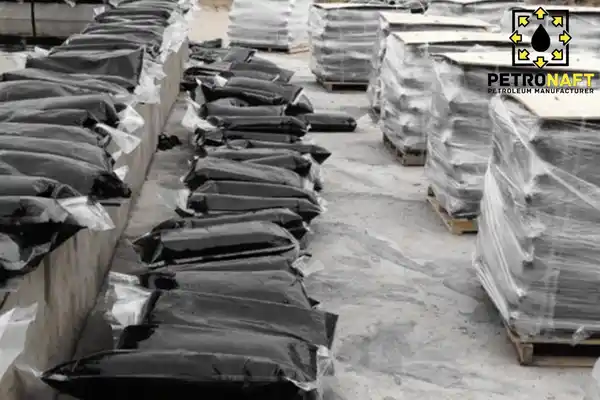
Hello
İ request 200 ton oxidized 115/15
Hello, I hope you are well.
Please send your request to the following email:
[email protected]
Oxidized bitumen 115/15 i need sample to Peru, port Callao
Thank you for your comment, we will be in touch with you via email regarding bitumen 115/15.